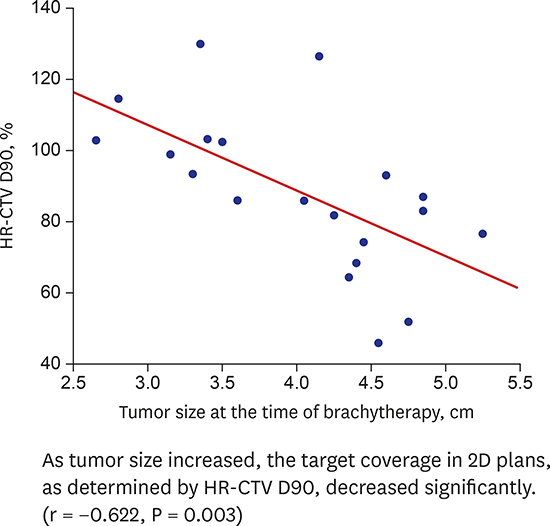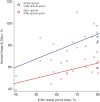1. Torre LA, Bray F, Siegel RL, Ferlay J, Lortet-Tieulent J, Jemal A. Global cancer statistics, 2012. CA Cancer J Clin. 2015; 65(2):87–108.

2. Moon EK, Oh CM, Won YJ, Lee JK, Jung KW, Cho H, et al. Trends and age-period-cohort effects on the incidence and mortality rate of cervical cancer in Korea. Cancer Res Treat. 2017; 49(2):526–533.

3. Eifel PJ, Winter K, Morris M, Levenback C, Grigsby PW, Cooper J, et al. Pelvic irradiation with concurrent chemotherapy versus pelvic and para-aortic irradiation for high-risk cervical cancer: an update of radiation therapy oncology group trial (RTOG) 90-01. J Clin Oncol. 2004; 22(5):872–880.

4. Rose PG, Bundy BN, Watkins EB, Thigpen JT, Deppe G, Maiman MA, et al. Concurrent cisplatin-based radiotherapy and chemotherapy for locally advanced cervical cancer. N Engl J Med. 1999; 340(15):1144–1153.

5. Keys HM, Bundy BN, Stehman FB, Muderspach LI, Chafe WE, Suggs CL 3rd, et al. Cisplatin, radiation, and adjuvant hysterectomy compared with radiation and adjuvant hysterectomy for bulky stage IB cervical carcinoma. N Engl J Med. 1999; 340(15):1154–1161.

6. Eifel PJ. Intracavitary brachytherapy in the treatment of gynecologic neoplasms. J Surg Oncol. 1997; 66(2):141–147.

7. Horwitz EM; American Brachytherapy Society. ABS brachytherapy consensus guidelines. Brachytherapy. 2012; 11(1):4–5.

8. Jamema SV, Saju S, Mahantshetty U, Pallad S, Deshpande DD, Shrivastava SK, et al. Dosimetric evaluation of rectum and bladder using image-based CT planning and orthogonal radiographs with ICRU 38 recommendations in intracavitary brachytherapy. J Med Phys. 2008; 33(1):3–8.

9. Kim RY, Pareek P. Radiography-based treatment planning compared with computed tomography (CT)-based treatment planning for intracavitary brachytherapy in cancer of the cervix: analysis of dose-volume histograms. Brachytherapy. 2003; 2(4):200–206.

10. Vargo JA, Beriwal S. Image-based brachytherapy for cervical cancer. World J Clin Oncol. 2014; 5(5):921–930.

11. Ohno T, Toita T, Tsujino K, Uchida N, Hatano K, Nishimura T, et al. A questionnaire-based survey on 3D image-guided brachytherapy for cervical cancer in Japan: advances and obstacles. J Radiat Res (Tokyo). 2015; 56(6):897–903.

12. Kim H, Kim JY, Kim J, Park W, Kim YS, Kim HJ, et al. Current status of brachytherapy in Korea: a national survey of radiation oncologists. J Gynecol Oncol. 2016; 27(4):e33.

13. Pötter R, Haie-Meder C, Van Limbergen E, Barillot I, De Brabandere M, Dimopoulos J, et al. Recommendations from Gynaecological (GYN) GEC ESTRO Working Group (II): concepts and terms in 3D image-based treatment planning in cervix cancer brachytherapy-3D dose volume parameters and aspects of 3D image-based anatomy, radiation physics, radiobiology. Radiother Oncol. 2006; 78(1):67–77.

14. Haie-Meder C, Pötter R, Van Limbergen E, Briot E, De Brabandere M, Dimopoulos J, Recommendations from Gynaecological (GYN) GEC-ESTRO Working Group, et al. (I): concepts and terms in 3D image based 3D treatment planning in cervix cancer brachytherapy with emphasis on MRI assessment of GTV and CTV. Radiother Oncol. 2005; 74(3):235–245.
15. Peacock JH, Eady JJ, Edwards SM, McMillan TJ, Steel GG. The intrinsic alpha/beta ratio for human tumour cells: is it a constant? Int J Radiat Biol. 1992; 61(4):479–487.
16. Pötter R, Knocke TH, Fellner C, Baldass M, Reinthaller A, Kucera H. Definitive radiotherapy based on HDR brachytherapy with iridium 192 in uterine cervix carcinoma: report on the Vienna University Hospital findings (1993–1997) compared to the preceding period in the context of ICRU 38 recommendations. Cancer Radiother. 2000; 4(2):159–172.

17. Nag S, Erickson B, Thomadsen B, Orton C, Demanes JD, Petereit D. The American Brachytherapy Society recommendations for high-dose-rate brachytherapy for carcinoma of the cervix. Int J Radiat Oncol Biol Phys. 2000; 48(1):201–211.

18. Vinod SK, Caldwell K, Lau A, Fowler AR. A comparison of ICRU point doses and volumetric doses of organs at risk (OARs) in brachytherapy for cervical cancer. J Med Imaging Radiat Oncol. 2011; 55(3):304–310.

19. Takenaka T, Yoshida K, Tachiiri S, Yamazaki H, Aramoto K, Furuya S, et al. Comparison of dose-volume analysis between standard Manchester plan and magnetic resonance image-based plan of intracavitary brachytherapy for uterine cervical cancer. J Radiat Res (Tokyo). 2012; 53(5):791–797.

20. Pötter R, Dimopoulos J, Georg P, Lang S, Waldhäusl C, Wachter-Gerstner N, et al. Clinical impact of MRI assisted dose volume adaptation and dose escalation in brachytherapy of locally advanced cervix cancer. Radiother Oncol. 2007; 83(2):148–155.

21. Hashim N, Jamalludin Z, Ung NM, Ho GF, Malik RA, Phua VC. CT based 3-dimensional treatment planning of intracavitary brachytherapy for cancer of the cervix: comparison between dose-volume histograms and ICRU point doses to the rectum and bladder. Asian Pac J Cancer Prev. 2014; 15(13):5259–5264.
22. Mazeron R, Kamsu Kom L, Rivin del Campo E, Dumas I, Farha G, Champoudry J, et al. Comparison between the ICRU rectal point and modern volumetric parameters in brachytherapy for locally advanced cervical cancer. Cancer Radiother. 2014; 18(3):177–182.

23. Kang HC, Shin KH, Park SY, Kim JY. 3D CT-based high-dose-rate brachytherapy for cervical cancer: clinical impact on late rectal bleeding and local control. Radiother Oncol. 2010; 97(3):507–513.

24. Tharavichitkul E, Mayurasakorn S, Lorvidhaya V, Sukthomya V, Wanwilairat S, Lookaew S, et al. Preliminary results of conformal computed tomography (CT)-based intracavitary brachytherapy (ICBT) for locally advanced cervical cancer: a single institution’s experience. J Radiat Res (Tokyo). 2011; 52(5):634–640.

25. Mahantshetty U, Tiwana MS, Jamema S, Mishra S, Engineer R, Deshpande D, et al. Additional rectal and sigmoid mucosal points and doses in high dose rate intracavitary brachytherapy for carcinoma cervix: a dosimetric study. J Cancer Res Ther. 2011; 7(3):298–303.











 PDF
PDF Citation
Citation Print
Print






 XML Download
XML Download